
The year 2023 marks the 10th anniversary of the Belt and Road Initiative. Proposed by China in 2013, the Belt and Road Initiative, aiming to boost connectivityalong and beyond the ancient Silk Road routes, refers to the Silk Road Economic Belt and the 21st-Century Maritime Silk Road. Ken Hammond, professor of global history and East Asian history at New Mexico State University, the U.S., shared his opinions on the initiative from a historical perspective with Beijing Review reporter Li Nan. Excerpts from their conversation follow:
Beijing Review: How has the Western perception of the Belt and Road Initiative evolved over the past decade?
Ken Hammond: When the Belt and Road Initiative got underway 10 years ago, one thing many Americans did know about China was the idea of the Silk Road. That’s something out there in popular culture in various ways. They understood that it was, in some ways, an evocation of the Silk Road and the idea of connections between China and other parts of the world.
But as China has reemerged as a significant player in global affairs, there’s been a rethinking or a re-representation of the “Belt” and the “Road.” So now what Americans hear, are accusations of what they call “debt diplomacy,” the idea that China is somehow luring developing countries into obligations of financial indebtedness, which will damage the countries and benefit China in some exploitative or extractive way.
And the irony is that it’s a projection of the actual behavior the United States has followed onto China. Because through direct American loans and assistance, that’s actually been the experience we’ve had: Capitalism in America has sought out ways to profit around the world, and has tried to develop economic relationships with other countries, based on enriching American corporations.
And so when we look at other countries, and when we look at China specifically, that’s just how Americans think about things. They look at the world through the lens of our own historical practices.
Why does the West appear to have so much trouble understanding China?
There are differences in language, differences in historical culture and differences in the ways we think about the world. That’s just the nature of things.
But there’s also this willful distortion on the part of political and corporate and media elites; one that’s very politicized and part of what they consider a struggle for dominance. Since the end of World War II, and especially after the fall of the Soviet Union in 1991, America, for a long time, has been the dominant power. We believed that, in many ways, we had reached a kind of unipolar world in which everything was going to revolve around the U.S.
And that’s now changing as the result of very deep historical processes, the diffusion of modern, productive technologies and the ability of China to be innovative and creative. The simple accumulation of experiences and wealth through the hard work of people—not just in China, but in many countries around the world—is redistributing wealth today.
The American elites, unfortunately, can only see that as a threat to their power and privilege and the continuation of their dominant role in world affairs.
They are intentionally, willfully fostering these negative views about China, putting out information which I think they know isn’t accurate or real and perpetuating these ideas about China that make it very hard for ordinary Americans to understand and appreciate what’s going on.
I’ve spent many years traveling through China with groups of American tourists from time to time. And it’s always amazing to me that when we arrived in China, maybe two or three days into the trip, people would start asking me, “What’s going on here? Where are all the police? Why are these people so well-dressed? Why do they look so happy?” Because there’s just this mythology that “China is an authoritarian society where everyone is oppressed and everybody’s miserable. It’s just a terrible place.” And when people then see the reality of China, it just shakes them up.
But most Americans will never have that experience. All they hear, all they know, is what they hear from their government, from their politicians and in the mass media, i.e., the corporate media.
In the face of conflict, China prefers to achieve peace via dialogue and mediation, whereas the American idea is that peace and security may even be achieved by unilaterally using force or through regime change. What are the roots of these differences?
We can see this very concretely right now. We can see it in China’s brokerage of an agreement between Saudi Arabia and Iran in March, and we can also see it in the China-proposed Global Security Initiative. And we can see it in China’s 12-point proposal to end the conflict in Ukraine [issued in late February].
China takes everybody’s interests seriously and tries to find a path forward that minimizes conflict. Maybe we’re not going to resolve everything. Maybe it’s not going to be necessarily one big group hug. But it respects the interests of the various parties involved. And I think that has deep roots in Chinese historical tradition.
In China, there has always been the idea of unity. When we talk about tianxia, literally “under Heaven,” that’s all of us, that’s everybody. And it isn’t just people. It’s people, animals, plants, the soil, the water, the air… We are all connected.
Whereas Europe, after the collapse of the Roman Empire over 1,500 years ago, has remained a fragmented place, where, historically, it’s all been about conflict. And it’s all been about who can impose power on others.
The United States is certainly not in Europe, but we are the outgrowth of those European traditions. And so we do have a culture that emphasizes the resolution of conflict by one side defeating the other. It’s not a culture that is based on the idea of finding common ground. Our legal system is what we call an “adversarial system.” It’s based on the idea that to resolve conflicts, you prefer to take those conflicts to the point where one side wins, rather than trying to navigate a path that will satisfy everybody’s interests and needs.
And I think this is almost a psychological distinction between Western societies and, let’s say, the Confucian-influenced cultures in East Asia, primarily in China itself. We see the Five Principles of Peaceful Coexistence that go back to Premier Zhou Enlai in the 1950s—e.g., the nonaligned movement of respect for territory and sovereignty, looking for mutual benefit, the idea of mutuality, of shared interest—emphasizing more what can bring us together rather than what’s going to split us apart.
We need to be able to learn from that and apply the same ideas, the same principles to solving our problems in a way that then becomes mutually beneficial, becomes a future of shared prosperity.
We must find a way to advance what will raise the livelihoods of people all around the planet. China has made incredible gains in eliminating absolute poverty, raising hundreds of millions of people to a better life. This is a historic accomplishment that no other country on Earth can claim as much of. We can read in Xi Jinping: The Governance of China, in the different volumes, this vision of a world that isn’t just about one group, one country, one society, but is about solving the problems that we all face in a way that will enhance all of our circumstances. But there is still so much to be done.
Things like the Belt and Road Initiative are therefore important. This vision of a future of shared prosperity for humanity, a future of mutual benefit [is important]. That’s the only path forward. –The Daily Mail-Beijing Review news exchange item




